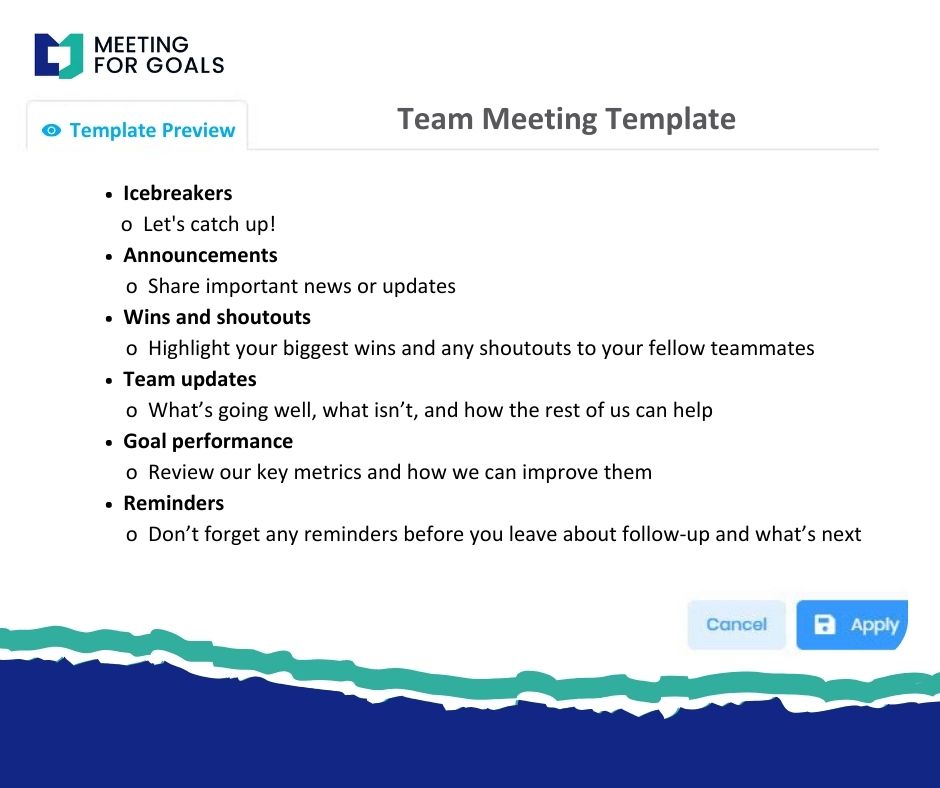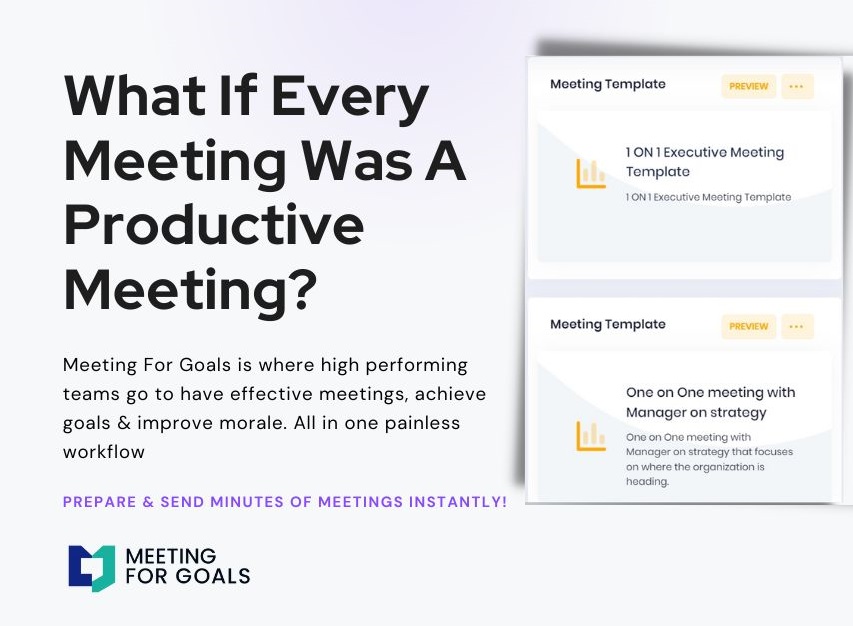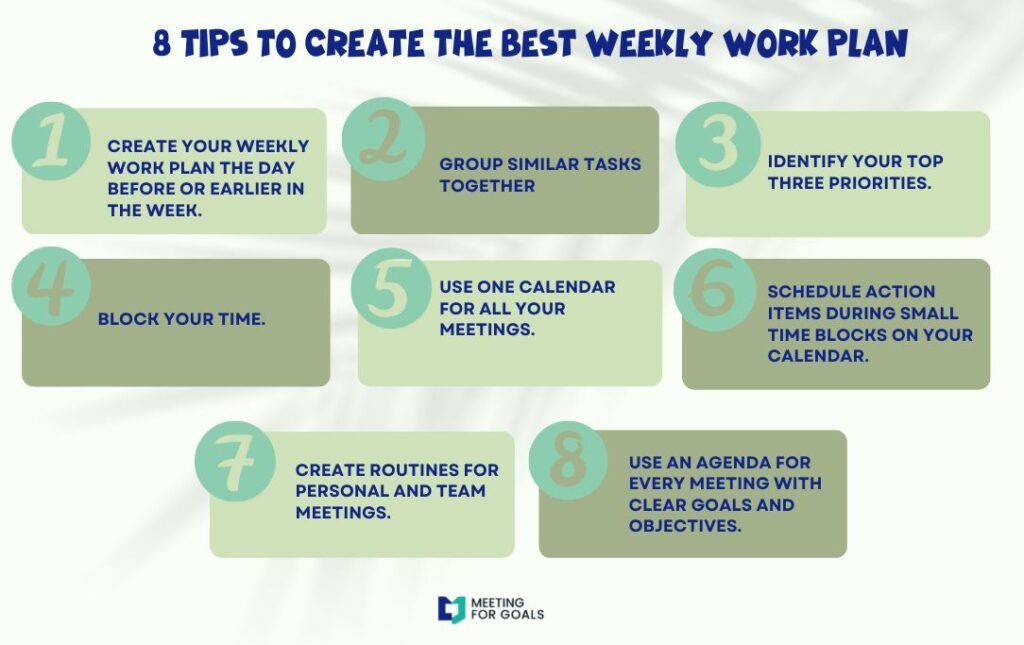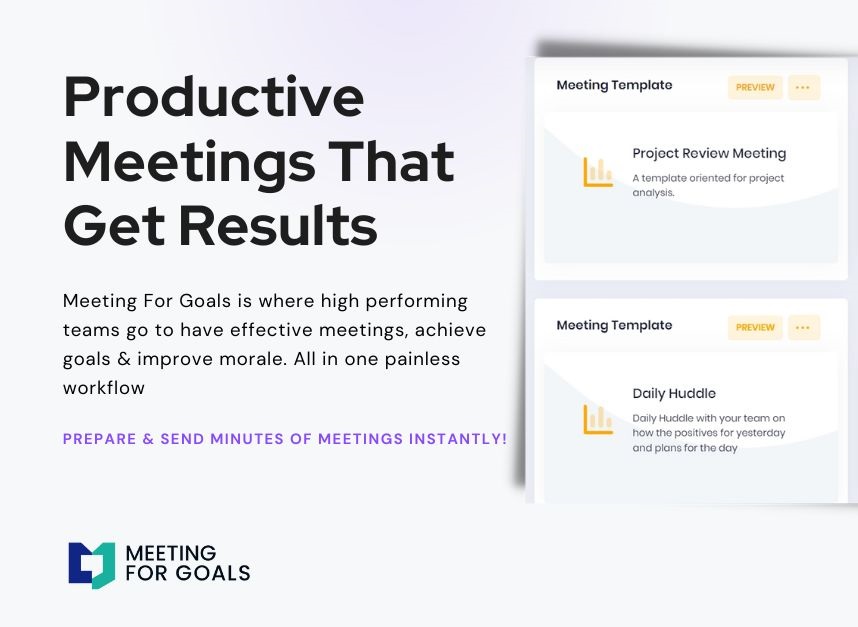Naming Meetings: Optimizing Engagement and Focus
Excerpt:
Meetings are a crucial part of any successful team. However, their effectiveness often depends on structure and purpose. One simple yet powerful way to improve meeting productivity is by giving them thoughtful names. A well-chosen meeting name sets expectations, aligns participants with objectives, and fosters engagement.
In this article, we’ll explore why meeting names matter, share actionable tips, and highlight common mistakes to avoid. By the end, you’ll have a clear strategy for naming meetings that drive results. Plus, we’ll introduce how Meeting For Goals can help streamline your meeting management process.
2 Minute Video
Watch a 2 minute demo of our meeting management software in action
I. Introduction
Meetings are the backbone of teamwork. Whether it’s a strategic planning session, a weekly check-in, or a problem-solving discussion, they help teams align, make decisions, and drive progress. However, poorly structured meetings can waste time, drain energy, and lower productivity.
One of the easiest ways to improve meetings is by giving them clear, purposeful names. A meeting’s name is more than just a label—it sets expectations, communicates objectives, and influences participation.
At Meeting For Goals, we specialize in helping teams run more effective meetings. Our platform helps reduce meeting times, increase engagement, and ensure discussions stay goal-focused.
In this guide, we’ll explore the psychology behind effective meeting names, share practical tips, and provide real-world examples. By the end, you’ll have the tools to transform your meetings into high-impact sessions.
Adding an Agenda
How to add an agenda instantly on Meeting For Goals
II. The Role of Meeting Names in Team Dynamics
A. First Impressions: How a Meeting’s Name Sets the Tone
The meeting name is the first thing attendees see on their calendar. A vague title like “Team Meeting” or “Check-In” doesn’t provide any context or motivation. In contrast, a name like “Q2 Strategy Alignment” or “Product Innovation Sprint” clearly communicates purpose and urgency.
A well-named meeting helps participants understand what to expect, making them more likely to prepare and engage.
B. Enhancing Engagement Through Descriptive and Purposeful Titles
A compelling meeting name encourages participation. Compare “Review Meeting” with “Customer Success Deep Dive”—the latter signals a focused discussion with actionable insights.
When employees know a meeting’s purpose in advance, they can come prepared, making discussions more effective and engaging.
C. The Psychological Impact of a Well-Chosen Name on Team Members
Studies in behavioral psychology suggest that clear, action-oriented language increases motivation and focus. A meeting titled “Revenue Growth Strategy Session” signals importance and encourages attendees to contribute ideas.
On the other hand, a generic title like “Sales Meeting” may not evoke the same level of engagement. Thoughtful naming fosters a culture of accountability and purpose, ensuring meetings are seen as valuable rather than a waste of time.
III. Tips for Naming Meetings
A. Keep It Concise: The Importance of Brevity
A meeting name should be short and to the point. Avoid long, convoluted titles that confuse attendees. Ideally, a name should be under five words and immediately convey the meeting’s focus.
B. Incorporate Goals: Aligning the Name with Objectives
A meeting’s name should clearly reflect its desired outcome. Instead of “Project Discussion”, opt for “Q3 Marketing Strategy Review” to emphasize the focus and expected deliverables.
C. Use Action Verbs: Creating a Sense of Purpose and Urgency
Action-oriented language makes meetings feel more dynamic. Compare “Budget Meeting” with “Budget Optimization Workshop”—the latter implies active participation and problem-solving rather than just a passive discussion.
D. Encourage Creativity: How Brainstorming Can Lead to Innovative Titles
Encouraging your team to brainstorm creative meeting names can make the process more engaging. Unique names like “Mission Possible: Sales Expansion” or “Innovation Lab: Product Development” can make meetings feel exciting while maintaining professionalism.
E. Consider Audience and Context
Different teams may respond better to different naming styles. A marketing team might appreciate “Brand Growth Strategy”, while an engineering team might prefer “Tech Roadmap Review”. Tailor the name to fit your audience.
IV. Examples of Effective Meeting Names
A. Showcase Examples of Well-Named Meetings
Here are some examples of well-structured meeting names:
- Strategic Brainstorming – Encourages creative thinking for long-term planning.
- Weekly Alignment Check-In – Ensures teams stay on track with goals.
- Customer Insights Roundtable – Focuses on customer feedback and strategy.
- Revenue Growth Strategy Session – Prioritizes business expansion tactics.
B. Categorized Examples Based on Meeting Type
- Status Updates – “Monday Morning Stand-Up”, “Weekly Progress Sync”
- Workshops – “Growth Hacking Workshop”, “Leadership Development Lab”
- Brainstorming Sessions – “Innovation Sprint”, “Creative Think Tank”
- Problem-Solving Meetings – “Crisis Response Strategy”, “Process Optimization Roundtable”
C. Discussion of Unconventional Names That Sparked Engagement
Some companies have experimented with unique meeting names to boost engagement. A tech company renamed its weekly update from “Team Meeting” to “Mission Control”, creating a sense of excitement and importance.
Another organization replaced “Quarterly Review” with “The Big Picture Session”, encouraging strategic thinking.
V. Common Pitfalls to Avoid When Naming Meetings
A. Vague or Generic Titles That Lack Focus
Titles like “Team Discussion” or “General Meeting” fail to set expectations, leading to low engagement and unclear objectives.
B. Overly Complex Names That Confuse Attendees
While creativity is valuable, avoid names that are too cryptic or lengthy. A name like “Cross-Functional Synergy Optimization Session” is unnecessarily complicated.
C. Failing to Reflect the Agenda or Outcome of the Meeting
A meeting name should clearly indicate its purpose. If the title doesn’t align with the content, attendees may feel misled or unprepared.
D. How Naming Practices Can Impact Accountability and Meeting Effectiveness
A well-named meeting reinforces accountability by clearly defining objectives. If a meeting is called “Customer Retention Strategy”, participants know they are expected to contribute ideas on improving retention rather than just passively listening.
VI. Conclusion
A. Recap of How Appropriate Meeting Names Can Enhance Productivity and Engagement
Effective meeting names set expectations, improve engagement, and drive better outcomes. By making small changes to how meetings are named, teams can significantly enhance their productivity.
B. Call to Action to Implement Thoughtful Naming Strategies in Meetings
Leaders should start renaming their meetings today to reflect clear goals and objectives. Encourage your team to adopt action-oriented, concise, and engaging titles to make meetings more effective.
C. Encouragement to Utilize Meeting For Goals’ Software for Enhanced Meeting Management and Goal Alignment
At Meeting For Goals, we help teams streamline their meetings, align discussions with company objectives, and improve accountability. Our software ensures that every meeting is focused, productive, and goal-oriented.
Try Meeting For Goals today and transform your meetings into powerful tools for success!
By implementing these strategies, high-level executives can optimize their team’s meeting culture, ensuring that every session serves a clear purpose and drives meaningful results. Start renaming your meetings today and experience the difference! 🚀
For further insights on meeting efficiency, check out Harvard Business Review’s guide to effective meetings. Also, explore Forbes’ tips on improving workplace communication.




